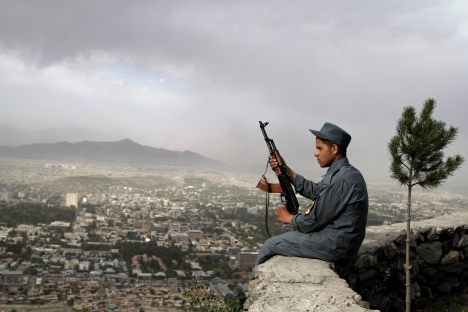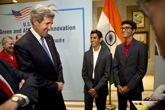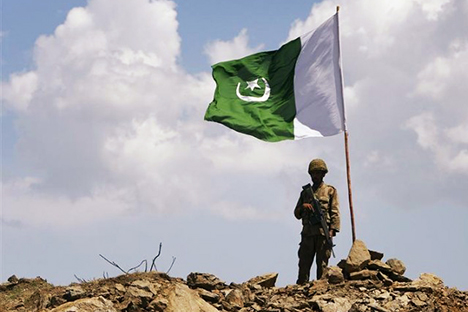India grapples with an Afghan war idiom

India will not be casting itself in a favorable light as an exponent of regional peace and stability if it is seen as queering the pitch of its rivalry with Pakistan on the Afghan turf. Source: AP
The war idioms can be quite figurative. The best war idiom to come out of Afghanistan in the past decade has been coined, inevitably, by the United States – ‘capacity building’. It was meant to indicate the urgency of assisting the regeneration of Afghanistan’s sinews of nation building that got atrophied through the decades of war.
India plunged into the enterprise of ‘capacity building’ dutifully and claims to have spent $2 billion over it in the past decade by building roads, constructing an edifice for Afghan parliamentarians to sit and deliberate on lawmaking, executing irrigation projects and so on. But a matter of definition has lately arisen.
In the post-2014 scenario, Delhi is wondering if ‘capacity building’ as applied to the Afghan armed forces can be stretched beyond the existing program of helping to train the military personnel in the Indian war colleges so as to include also the supply of war equipment – in short, enhancing Afghanistan’s capacity to fight wars.
Kabul has reportedly handed over to Delhi a 17-page list of military equipment it needs, which includes such items as armored vehicles, 105 mm artillery guns, utility helicopters, trucks, communication equipment and the like. Conceivably, this falls within the ambit of ‘capacity building’ since a country must first survive in a difficult environment, after all, and be capable of defending itself. But then, there is an equal part to be said to negate that argument too.
Be that as it may, there is a vocal lobby in India, which feels that Kabul is offering an “opportunity” to Delhi to establish a military-to-military relationship with Afghanistan. The unspoken leitmotif is that India should seize the opportunity and use the relationship with the Afghan armed forces as leverage to put pressure on Pakistan by creating a “second front” for the old adversary. But on the other hand, India’s “capacity” to equip the Afghan armed forces is rather limited. First, Delhi cannot expect payments from Kabul for the military equipment. Will the expenditure come out of India’s defence budget? This is one thing.
Of course, the sensible thing to do will be for Delhi to ask the North Atlantic Treaty Organization (or the US) to pick up the tab, which they have occasionally done in the case of procurements of helicopters from Russia that are suitable for Afghan conditions and which the Afghan armed forces have traditionally used. But it is unlikely that India will be put on a similar footing, because neither Brussels nor Washington will want to tread on Pakistani sensitivities. In fact, the US has not hidden its aversion to India being involved as a provider of security for Afghanistan. The US indeed lauds India as a “lynchpin” in the post-2014 Afghan security scenario, but this role is visualized exclusively in terms of Delhi loosening its purse strings and rendering financial support and economic assistance to that country.
A second problem arises insofar as India’s indigenous capacity to manufacture military equipment is very limited and what little India’s defence industry produces is needed for its own million-strong armed forces. Certainly, it makes no sense for India to procure weapons at own cost from third countries such as Russia, Israel, France, or the US and supply them gratis to the Afghan armed forces.
But there is a third issue, which is political. Without doubt, Pakistan’s sensitivity regarding India-Afghan military cooperation is understandable. In a similar situation, Delhi would not easily swallow the bitter pill if Beijing or Islamabad were to raise their heads above the parapet and build up military cooperation with, say, Nepal or Bhutan. Besides, there is already a perception that India-Pakistan rivalry is the root cause of the instability in Afghanistan, which, despite denials by Indian pundits has become entrenched as the narrative in the world opinion. In sum, India will not be casting itself in a favorable light as an exponent of regional peace and stability if it is seen as queering the pitch of its rivalry with Pakistan on the Afghan turf.
The ultimate clincher, however, will be that the Afghan situation is reaching a defining moment and Delhi will be acting injudiciously to focus on beefing up one particular group – albeit the Kabul government – in what is quintessentially a 30-year old fratricidal strife.
India is undeniably a stakeholder in the stability of Afghanistan. But it is still unclear that the prospects of peace and reconciliation stand no chance and Afghanistan is inexorably moving toward a civil war. The point is, much depends on whether Pakistan is capable of making a genuine shift in its approach toward the Afghan situation. Within Pakistan there are different schools of opinion. There is indeed a thoughtful opinion that is straining to assert, which has begun to openly question the continued logic of viewing the extremist elements of the Taliban as Pakistan’s ‘strategic assets.’ This topic of ‘strategic assets’ used to be a holy cow in the Pakistani discourses and the fact that it is openly discussed today itself underscores a significant shift in public attitude.
As of now, it is far from evident that the willingness to recognize the gravity of the blowback of the Afghan conflict for Pakistan’s own security is going to translate as official policies. There are indeed several power centres in Pakistan and what makes matters extremely delicate at the moment is that the Pakistani civilian leadership hopes to assume the reins of power in steering the Afghan policy and things are moving toward a delicate period in the near future.
However, the success of the Pakistani civilian leadership in asserting its control over the country’s Afghan policy will also critically depend on the climate of Pakistan’s relations with India. The civilian leadership of Prime Minister Nawaz Sharif has repeatedly stated its keenness to normalize Pakistan’s ties with India. Pakistan’s domestic and regional policies are inextricably linked and although many Indian pundits hate to hear it being said in as many words, the fact remains that improved India-Pakistan relationship will be a positive factor for the Afghan peace process. Suffice to say, it is in India’s own long term interests to encourage the positive trends in Pakistan that are inclined to make the leap of faith necessary to grasp that the stabilization of Afghanistan can be a game changer for Pakistan’s own security and development as well as for regional stability and cooperation as a whole.
On the contrary, any move on India’s part at this delicate juncture to raise its profile in Afghanistan will run the risk of creating misapprehensions in the Pakistani mind. It is a gamble that Delhi will be taking by remaining in a state of masterly inactivity in its Afghan policies through this year and the next, because there is no certainty that the winds of change in Pakistan will ultimately prove to be the prevailing winds. But it is a gamble still worth taking.
All rights reserved by Rossiyskaya Gazeta.
Subscribe
to our newsletter!
Get the week's best stories straight to your inbox
.jpg)

